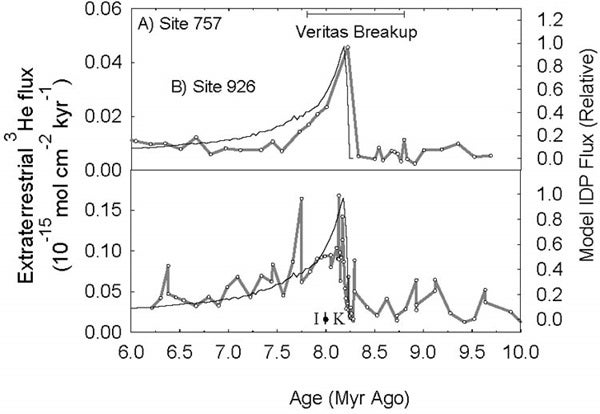Oceanic core samples reveal a sudden abundance of interplanetary dust particles in ancient seafloor sediments. Two samples, taken from sites in the Indian and Atlantic oceans, contain large amounts of micron-sized extraterrestrial (ET) dust in sediment estimated to be 8.2 million years old.
Ken Farley of the California Institute of Technology (Caltech) and his colleagues at the Southwest Research Institute in Boulder, Colorado, and Charles University in the Czech Republic attribute the abrupt spike in interplanetary dust found in seafloor sediments to the breakup of a 100-mile-wide (160 kilometers) main-belt asteroid known as Veritas. Their findings appear in the January 19 issue of the journal Nature.
Extraterrestrial dust — fine, rocky dust formed by asteroid collisions or comet ejections — is rarely found in large concentrations in seafloor sediment. Interplanetary dust particles typically comprise fewer than one per every million particles that make up seafloor sediment. The other 999,999 particles are of terrestrial origin.
ET dust particles are small and rare enough to elude direct detection. Fortunately, they can be found another way. Interplanetary dust particles are rich in the rare isotope helium 3. Farley, in a decade-long quest to build an overall record of interplanetary-dust flux, measured concentrations of helium 3 in sediments that date as far back as 75 million years ago. In both oceanic core samples, he found a sharp, fourfold rise in helium 3 in 8.2-million-year-old seafloor sediments, then a gradual decrease for some 1.5 million years afterward.
To find the excess ET dust’s parent body, scientists identified asteroid clusters that may have been one huge asteroid 8.2 million years ago and then used computer simulations to trace the asteroid fragments’ orbits back in time. The likely candidate is asteroid Veritas, which orbited in the main asteroid belt between the orbits of Mars and Jupiter. The date of this asteroid’s breakup coincides with the peak in the interplanetary dusting event on Earth.











